Photos of Waffen-SS officers
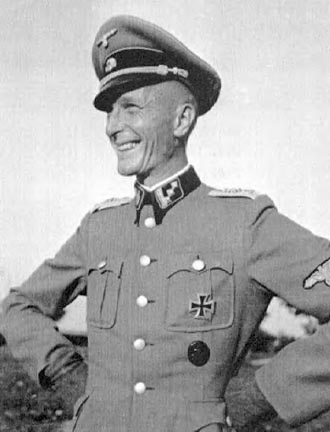
The man in the photo above is Adolf Otto
Diekmann, the battalion commander who was the highest ranking
officer present at Oradour-sur-Glane on June 10, 1944 the day
that 642 men, women and children were murdered and the whole
town was destroyed by fire. In most books, his name is given
as Otto Dickmann; SS records show that his name was Adolf Otto
Diekmann. It was common for German men at that time to use their
middle name.
After the massacre at Oradour-sur-Glane
Diekmann made a report at 5:30 p.m. that day to his commanding
officer at the Regimental Headquarters in Limoges.
The following quote from Diekmann's Report
was included in Otto Weidinger's book, "Comrades to the
End":
The Company had encountered resistance
in Oradour, the bodies of executed German soldiers were found.
It then occupied the village and immediately conducted an intensive
search of the houses. Unfortunately this failed to turn up Kämpfe,
however large quantities of weapons and ammunition were found.
Therefore all the men of the village were shot, who were surely
Maquisards.
The women and children were locked
up in the church while all this was going on. Then the village
was set on fire, as a result of which the ammunition that was
stored in almost every house went up. The burning of the village
resulted in fire spreading to the church, where ammunition had
also been hidden in the roof. The church burned down very rapidly
and the women and children lost their lives.
The "executed German soldiers"
mentioned in the report was a reference to wounded German soldiers
in an ambulance who had been burned alive. The driver and another
soldier sitting in the passenger seat had been chained to the
steering wheel before the vehicle was set on fire. There were
also bodies of German soldiers found in an old well in Oradour-sur-Glane.
Diekmann was court-martialled but the
charges were dropped after he was killed in action on June 29,
1944 at Normandy.
Robert Hebras, one of the 5 survivors
of the Laudy barn, wrote a book called "Oradour-sur-Glane,
the Tragedy Hour by Hour," in which he described Diekmann
as a "blood-thirsty man" and said that "Major
Dickmann was a man whose callousness had earned him the reputation
of a cold, cruel butcher, and a drunkard besides."
Diekmann lies buried in the huge La Cambre
Cemetery at Normandy where the bodies of 21,115 German soldiers
were laid to rest. During the 60th anniversary ceremonies at
Normandy, German Chancellor Gerhard Schroeder took part, but
he made it a point not to visit La Cambre to pay his respects
to the German soldiers who gave their lives for their country.
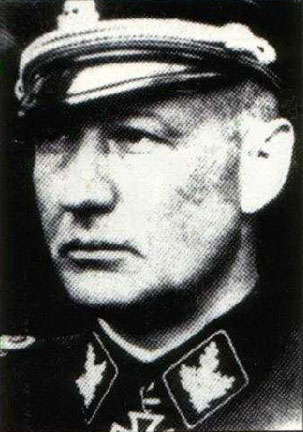
Beginning in 1943, Das Reich Division
was under the command of General Heinz Bernard Lammerding, who
is shown in the photo above. The Center of Memory in Oradour-sur-Glane
maintains that General Lammerding gave the order to destroy the
village before the soldiers went there. This accusation is based
on a memorandum, dated June 5, 1944, in which Lammerding outlined
the measures to be taken in areas where the French resistance
was fighting as illegal combatants in defiance of the Armistice
signed by France in June 1940, and on an Order of the Day issued
on June 9, 1944. This order, entitled "The Position with
Regard to Guerrilla Bands and Tactics for Combatting Them,"
explicitly mentioned the reprisals that were to be taken against
the insurgents. Reprisals were legal under the Geneva Convention
of 1929.
Lammerding lived out his days in West
Germany, working as a civil engineer, and died in 1971. He was
never brought to trial, but was convicted in absentia in 1951
for ordering a reprisal in response to the murder and mutilation
of captured German soldiers in Tulle on June 9, 1944. He was
again convicted in absentia in 1953 for ordering the reprisal
against Oradour-sur-Glane on June 10, 1944, a charge which he
denied.
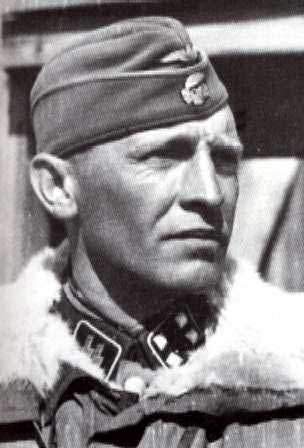
The photo above shows Sylvester Stadler,
who was Diekmann's commanding officer. When Stadler heard about
the massacre and the destruction of Oradour-sur-Glane, he reported
Diekmann to Brigadeführer Heinz Lammerding and requested
that Diekmann be court martialled for exceeding his orders. Diekmann
was court martialled but never brought to trial since he was
killed in action a few weeks later. His fellow officers said
that Diekmann was distraught; they believed that Diekmann committed
suicide by deliberately getting himself killed in battle.
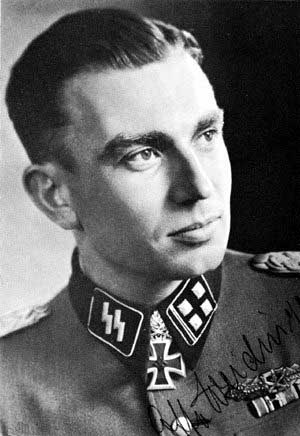
The photo above is a formal portrait
of Otto Weidinger, who was the last commander of Der Führer
regiment in Das Reich Division. Weidinger defended Diekmann's
actions in ordering the destruction of Oradour-sur-Glane; he
testified for the defense at the trial of 21 of the perpetrators
in 1953.
Weidinger wrote a book about his regiment,
entitled "Comrades to the End," in which he said that
Diekmann had the authority to order a reprisal action under the
Sperrle Order given on February 3, 1944. Weidinger also claimed
that he had met Rene Jugie, the former Maquis chief for the Dordogne,
who went by the name Gao, in 1969 in Paris. Jugie admitted that
Oradour-sur-Glane had indeed been filled with weapons and ammunition.
It was, in fact, the supply center for weapons for all the towns
and villages in the Dordogne, according to Weidinger's account
of his meeting with Gao.
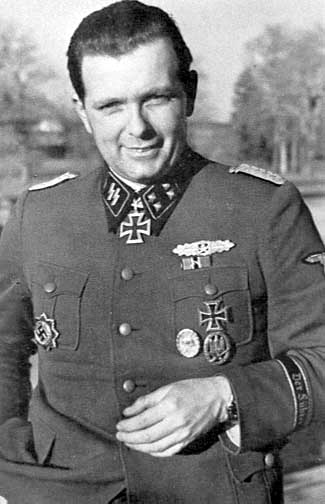
The man in the photo above is Major Helmut
Kämpfe, the commander of Der Führer Battalion 3, who
was kidnapped by members of the FTP, the French Communist resistance,
on 9 June 1944. The SS soldiers claimed that the reason for going
to Oradour-sur-Glane on June 10, 1944 was to look for Kämpfe,
an officer who was very well liked and a close friend of Adolf
Diekmann. On the day of the massacre, Diekmann had been given
information about Kämpfe by two collaborators in the Milice,
the French secret police which helped the German Gestapo. Allegedly,
the French resistance fighters in Oradour-sur-Glane were going
to execute Kämpfe by ceremoniously burning him alive that
day. Kämpfe was the highest ranking officer ever to be captured
by the resistance. His execution was to be a big event.
Kämpfe was killed by the French
resistance, but not at Oradour-sur-Glane. His place and date
of execution was allegedly in Breuilaufa, a village just north
of Oradour-sur-Glane, on 10 June 1944, although some sources
say that his burned body was found in Oradour-sur-Glane. As illegal
combatants, who were fighting in violation of the Geneva convention
of 1929, the Communist resistance fighters didn't bother with
such niceties as the rules of the Geneva Convention with regard
to Prisoners of War.
From his photo, Kämpfe appears to
be a pleasant and likable fellow, and it seems that he had earned
a lot of medals for his heroic actions while he was fighting
the Communists on the eastern front.
Photo of French Resistance Hero

The man in the foreground in the photo
above is Georges Guingouin, the French commander of the FTP,
the Communist resistance organization that waged guerrilla warfare
against the Germans during World War II. This photo was taken
on March 4, 1945 on the occasion of a speech in Limoges by Charles
de Gaulle, the leader of the French resistance. Limoges, which
is 14 miles from Oradour-sur-Glane, was the center of the French
resistance, according to de Gaulle's speech. After the war, Guingouin
became the mayor of Limoges. The French resistance played a significant
role in the liberation of Europe from the Nazis.
Helmut Kämpfe was kidnapped by FTP
fighters, led by Jean Canou, and turned over to Guingouin, the
Communist leader who probably ordered his death on the day that
the village of Oradour-sur-Glane was destroyed.
This page was last updated on August
24, 2009
|